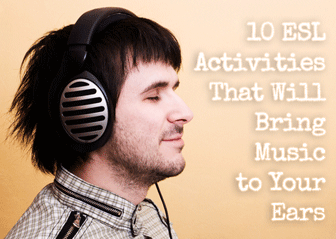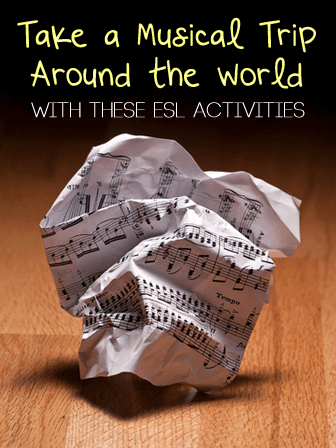10 ESL Activities That Will Bring Music to Your Ears


People all over the world find pleasure and enjoyment in listening to music. Because music is something to which you and your students will probably relate, at least on some level, why not use it as a starting point for a language unit? Your students will appreciate the opportunity to share some of the music that is important to them, and they can use the musical studies as a chance to further increase their language skills!
Music is special in its ability to tap into the very center of our beings. Simple strings of notes connected together to make a melody can sometimes penetrate the very center of our selves. Classical music is unique in that it not only touches its listeners, but it also frees the mind to imagine a story or an image to go along with the wordless music. Using a piece of classical music for inspiration, have your students write a description or story based on a selection of your choice. To do this, choose a piece of music that does not have lyrics to play for your class. A five to ten minute selection is probably a good length, depending on the age of your students. You should give your students a large piece of blank paper and some crayons, markers, pastels or other drawing materials. As you play the selection, ask your students to draw something inspired by what they hear. They may want to draw something that progresses with the music, such as a story or scene. They may also want to draw something more abstract, reacting to the music in one ever-expanding image. Explain to your students that either approach is acceptable.
Once the music is over, give your students some class time to write about what they have drawn. They may write a story that they found in the music. They may describe a person or a location that they heard the music describing. They may choose to write something completely different. Encourage creativity and originality in your students’ writing, and make sure they know they have the freedom to write anything they choose. Once your writing time is up, put your students in pairs to talk about what they heard in the music and what they wrote during the writing session. You may then want to ask volunteers to share what they have written with the entire class. One advantage to approaching this activity with art first and then with writing and conversation is that you eliminate the language barrier as your students listen to the classical selection. This will allow them to be more creative and gain more inspiration from the music, which can then be channeled in to their speech and writing.
Stephen Foster is considered one of the greatest musicians in American history. His earthy music written in the 1800’s speaks to a simpler time in the history of the United States. One unique quality that his songs hold is their geographical references. Many of his songs mention different areas of the U.S. Some of these songs include Oh, Susanna!, Sewanee River, Camptown Races, and My Old Kentucky Home. Break your class into groups and assign one of these songs to each group. Then have the groups research two things. First, have each group research the geographical region mentioned in the song. What information can your students find out about that region today and that region in the 1800’s? How has it changed over time? Why would this be a good location to write about? Second, have your students do some research on the song itself. What types of people sang it? Why did they sing it? Why did Foster write it? If you like, you can use this as an opportunity to explain how to do library research. If you have computers available to your students, they can also use the internet to locate their information. After they have completed their research, ask each group to create two posters, which explain the information they discovered during their research – one for the geographical region and one for the song. If possible, dedicate a bulletin board in your classroom to the research results. Draw or post a map of the United States on the bulletin board and then display the posters near the geographical regions they mention.
If you have the resources, you can download the free app “Top 100 Hits” by Sixpack. This music application lists the top 100 songs in twenty-three countries around the world. Your students may enjoy exploring the music that is most popular in their home countries and those of their classmates. This can be done best in groups of two or three students. Have your students take note, as they explore, which songs are popular across national borders. Encourage your students to share in a class discussion any thoughts or feedback they have on their experience.
Follow this activity with some class presentations. Ask each person to bring in a song he or she would like to share with the class. (Plan ahead what resources you will need to play the music for the class.) Each person should talk about the song he has chosen. Have your students share what the song means, why they like it, and whether or not they would like to meet the singer or group who sang the song.
If you like, follow up by having each person write either 10 interview questions she would ask the group and the answers she thinks they would give or an article about the artist to be featured in a music magazine. You may want to have some copies of Rolling Stone or other music magazine available for your students to use as a model. Then compile all the interviews and articles into your own class magazine which features music from around the world.
It has the ability to touch the very cores of our being and elicit emotional responses from us as we listen. Giving your students an opportunity to make a musical connection with their English studies will help them learn in a new way and give them the chance to share with you and the class on a more personal level.